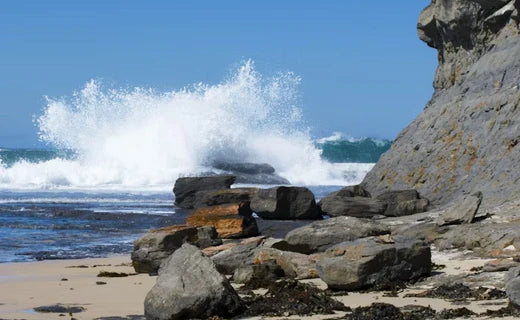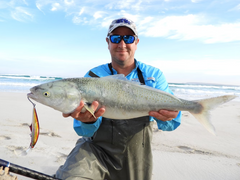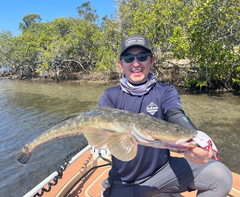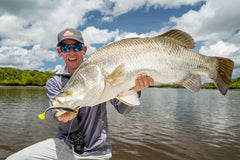Rock Fishing Guide
Rock fishing is a popular pastime Australia-wide, and it seems just about wherever you go, there are local thrill seekers looking to take advantage of any favourable weather conditions to wet a line from the rocks. Rockhoppers young and old will often study weather trends for days leading up to a trip, hoping to find a good spot on their chosen ledge and cross paths with trophy fish.
Rock fishing is far more than just a casual hobby for most who do it; it’s more like an extreme sport. As such, jumping straight into this fast-paced, high-octane, and potentially dangerous activity is not recommended without the right knowledge. For anyone wanting to break into the rock hopping world, this guide covers the essentials of rock fishing, including preparation, safety, tackle, and tips.
What Is Rock Fishing?
Rock fishing is any land-based fishing from rocks, usually in the form of a headland or promontory jutting out into the ocean, a break wall at the mouth of a river, or a rocky outcrop along a beach. These areas are known for receiving high volumes of sea swell, making fishing from them both challenging and potentially hazardous.
This turbulent habitat often sees bits of growth and crustaceans broken away by the force of the waves, attracting omnivores and baitfish. These, in turn, draw in larger ocean predators. Fishing in such an exposed area requires knowledge, skill, and caution.

Rock Fishing Safety
Safety is paramount in rock fishing. Many accidents could have been avoided with the right precautions. Here are the essential safety rules for rock fishing:
- Rule One: Never turn your back on the ocean. Always keep an eye on the ocean to anticipate large waves and move off the ledge if necessary.
- Rule Two: Observe the ocean for at least 15-20 minutes before starting. Check the size and direction of swells and look for wet areas on rocks as indicators of wave reach.
- Rule Three: Fish with a buddy, especially if you’re new. Having someone with you provides extra safety, as they can watch the ocean while you’re focused on fishing.
- Rule Four: Have a plan. Know where you’ll go if a large wave approaches, how you’ll land fish safely, and what to do in case someone is washed in.
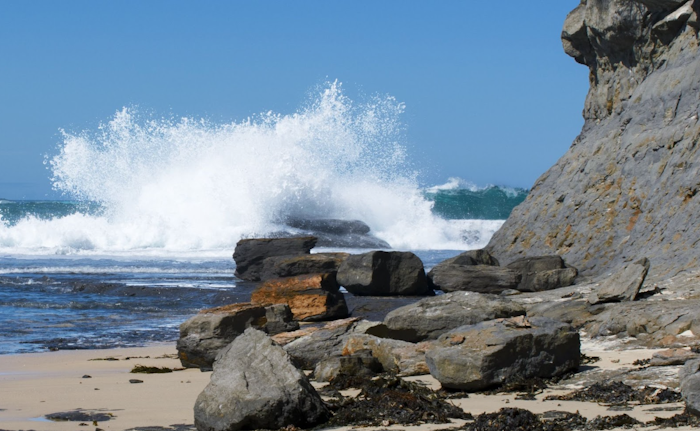
What appeared to be a good vantage point to fish from proved hazardous when a large wave set came in. It never pays to rush in.
Rock Fishing Equipment and Tackle
Proper safety gear is essential when rock fishing. Life jackets or PFDs are mandatory in some states and highly recommended in all others. The Watersnake Life Vest is a popular choice, with manual or automatic inflation options, compact and suitable for rock fishing.
Footwear should ideally be steel-spiked boots, like the Fish-O-Rock Spike Boots from Adrenalin, to prevent slips on wet rocks. Alternatively, felt-soled footwear offers secure footing by conforming to uneven surfaces, though it retains water. Your choice of footwear depends on your environment and preference.
Tackle
Your rod and reel setup depends on your target species. A 10 ft or longer rod and a 3000-5000 size spinning reel are versatile options. Recommended rods include the Daiwa Over There, Shimano Aerowave Graphite Surf, and Samaki Zing Gen 3 Surf Rod.
For reels, options like the Shimano Aerlex XSB, Daiwa Saltist MQ, and Okuma Rockaway provide durability and performance at a reasonable price. Your local Tackle World store can offer additional recommendations tailored to your needs.

Using Burley
Deploying a burley bag or cubing bait can increase your chances. Attach a burley bag filled with fish bits and breadcrumbs to the rocks to release enticing scents into the water, drawing fish toward your fishing area.
Rock Fishing Tips
Bait anglers often use monofilament line for its abrasion resistance, especially helpful when fishing near rocks. Lure anglers prefer braided lines for longer casts, though braid is less abrasion-resistant, so using a long rod to keep the line off the rocks during a catch is beneficial.
Landing fish involves timing with wave action to wash the catch onto the ledge, avoiding the impact zone. Having a buddy adds safety, as they can watch the waves while you handle the fish. Slide-down gaffs and extended nets are also helpful for safely bringing fish ashore.
Final Note
Rock fishing is thrilling but dangerous. Always prioritize safety over any catch, and never hesitate to let a fish go if landing it seems risky.
Let’s Rock!
Rock fishing is a challenging but rewarding activity. Those who embrace it often become lifelong enthusiasts, joining local rockhopper communities and sharing their expertise. If you're looking for a new adventure and enjoy a boat-free angling experience, rock fishing may be your next great pursuit.
For more tips specific to your area, visit your local Tackle World and consult their knowledgeable staff.


 Select Store
Select Store




